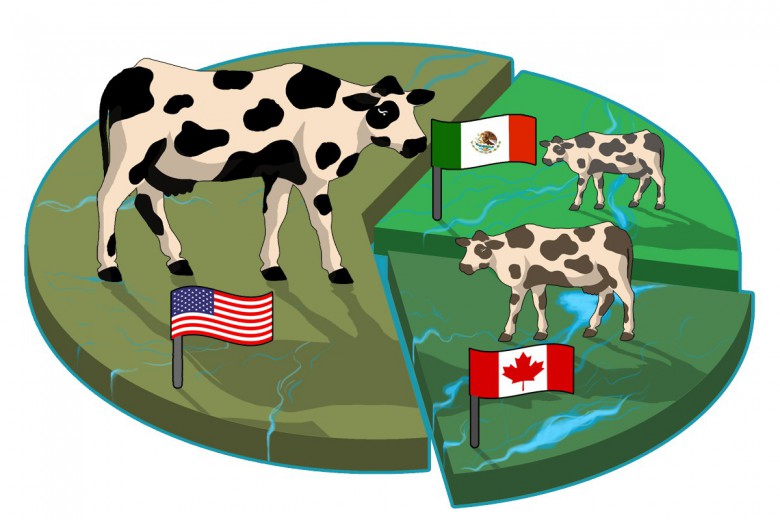The Green New Deal has gone mainstream. The idea is to combine a massive federal job creation program with bold action to rapidly shift away from fossil fuels and protect Indigenous rights. Long a buzzword in the U.S. Green Party, a Green New Deal resolution was introduced in February by insurgent Democrats like Alexandria Ocasio-Cortez, who’ve solidified its scope and demands. Now, Canadian leftist organizations like Courage are presenting their own proposals for a “Green New Deal of the North.” And in March, federal NDP leader Jagmeet Singh began voicing support for the Green New Deal idea.
But some are wary of proposals like the Green New Deal – they say that it only “greens” the capitalist imperative of perpetual economic growth, which is the true cause of environmental destruction. These critics – degrowthers – believe that to reduce our environmental impacts, we need to scale down energy and material use throughout the economy. This will likely lead to a downturn in gross domestic product (GDP) growth, so we need to restructure the economy so it doesn’t rely on economic growth as an indicator for well-being.
Unlike the Green New Deal, however, degrowth isn’t a policy platform – it’s more of a movement, or what participants call an “umbrella concept,” bringing together a wide diversity of ideas and social and environmental justice struggles. There are other differences between the two, but each brings something unique to the just transition table. What would a conversation between degrowth and the Green New Deal look like?
Similarities
- Thinking big. Both degrowth and Green New Deal proposals aren’t afraid to put forward visionary ideas.
- Diverse solutions. Instead of proposing a few one-size-fits-all policies, both argue for a diverse platform, touching on all sectors of the economy.
- Grounded in movement struggles. While the degrowth movement has strong links to environmental justice, climate justice, and alter-globalization movements around the world, Canadian proponents of the Green New Deal have links to labour, Indigenous, and climate justice movements.
- New economics. Both proposals draw from heterodox, post-Keynesian economic disciplines to advocate for a debt-free, co-operative economy.
- Caring economy. They also share an appreciation for what they call a “caring economy” – encouraging work that has low environmental impact and helps to address inequality, like health care, teaching, art, child care, and building community.
- Post-carbon and post-capitalist. By proposing to cut subsidies and benefits to fossil fuel companies, both projects have a post-carbon vision of the future. And, while there are capitalist boosters of both the Green New Deal and degrowth, many proponents on both teams see the proposals as fundamentally anti-capitalist – advocating for a society where everything is held in common.
- Internationalist. Degrowthers say that “the West must degrow so that the South can choose its own path of development,” and they include international solidarity in their core principles. The Green New Deal, though largely focused on Western countries, hopes to build an international solidarity economy, changing the uneven relationship between rich and poor countries.
Differences
Theory and policy
Degrowth is mostly an academic movement, focused on challenging mainstream economics. There have been some degrowth policy proposals, but there is not always agreement in the movement about those policies.
The Green New Deal, in contrast, is mostly a policy platform. Those who back it and worked on it may be academics and activists, but the focus is on putting together a visionary set of policies.
Growth
Because most evidence points to economic growth being strongly coupled with environmental destruction, degrowthers believe we should focus on reducing impact and restructuring the economy, even if that might mean less growth. Degrowthers argue that for the Green New Deal to lead to a post-capitalist future, it must not be tied to economic growth. But, they also acknowledge that a degrowth platform might be a hard sell politically, especially in North America.
Most Green New Deal platforms are either agnostic about, or supportive of, economic growth. Some Green New Deal advocates argue that it is possible to decouple environmental impact from economic growth. Courage’s platform does not mention the word “growth” once. The Green New Deal backed by Alexandria Ocasio-Cortez barely mentions it.
Consumerism
Degrowth has long been focused on the problem of consumerism, or, how we have created a high-waste economy where we are forced to buy crap that we don’t need. It is possible to increase well-being while dismantling the imperial mode of living, tied to an unsustainable capitalist system.
Green New Deal advocates often avoid talking about the need to reduce consumption, which is not seen as a popular selling point in North America – it’s met with backlash like Republican outcry that Ocasio-Cortez wanted to “take away their hamburgers.” Courage does mention the need to shift away from “individual and wasteful consumerism.”
Unique policies
Degrowth
- Degrowth would reduce the working week and support companies to facilitate job sharing between employees.
- Ecological tax reform, taxing expenditure and polluting activity instead of income. High taxes on income from capital and inheritance.
- Rehabilitate existing housing stock, with high taxes on empty homes and speculation.
- Reduce advertising, with strict criteria for advertising in public spaces, like in Grenoble, France.
- Basic and maximum income.
Green New Deal
- Fundamental to the Green New Deal is a job guarantee and funded retraining for fossil fuel industry workers.
- All new green jobs should be public, or community owned
- Raise minimum wages and guarantee workplace protection
- Grant migrants their democratic rights and access to services.
- Universal child care.
- Public transport in cities and public electric vans in rural areas; co-operative ride sharing.
- Recognize Indigenous sovereignty and offer equal services and locally owned energy in Indigenous communities.
- Large-scale construction of co-operative housing units.
- Ban planned obsolescence in design and manufacturing.
- Invest in co-operative and community banking, so that people’s money isn’t used to invest in harmful industry.
- Repurpose Canada’s arms industry for zero-carbon transportation.
- Strong human rights and environmental regulations for Canadian mining companies.
Problems
Degrowth
- The degrowth movement as a whole does not have a single policy platform. It’s not easy for people to access information about the concept or find out how it would impact them personally, since many of the conversations are academic.
- In English North America, the idea hasn’t totally caught on.
- Its criticism of consumption and anti-growth stance may alienate voters.
- How will we fund the degrowth transition, since most profits come from extractive industries?
Green New Deal
- Social movements in North America are weak and fragmented compared to the ’30s, when the New Deal was implemented – who will hold politicians’ feet to the fire the way unions did back then?
- It’s not very detailed on a local level, and policies may feel disconnected from people’s lives.
- How would it deal with the decentralization of the federal government and with different political systems at different scales – municipal, provincial, and national?
- Will there be social supports for people pushed out of the (shrinking) wage economy?
- How will it deal with the need to minimize unsustainable and wasteful consumption?
Solutions
Degrowth
- Degrowth needs to develop a more strategic program, make inroads into English North American discourse, and produce accessible media for non-academic audiences.
- Maybe it’s not yet time for degrowth as an electoral strategy in North America, but it should be used as a set of values and ideas to influence social movements.
- We need rigorous modelling and experimentation with degrowth policies to better understand how a post-growth economy would function.
Green New Deal
- The Green New Deal should develop an electoral strategy that interfaces between Green New Deal advocates, social movements, and political parties.
- It needs massive mobilization and education to build community-level networks of engaged citizens.
- It should join up policy-making at local and federal levels, as well as implement job sharing, expand the care-work sector, offer universal services for everyone to reduce living costs, and institute a basic income.
- It could also tax advertising; municipalize recycling, composting, and waste disposal systems; educate consumers; create community repair centres; and subsidize low-impact leisure activities.







